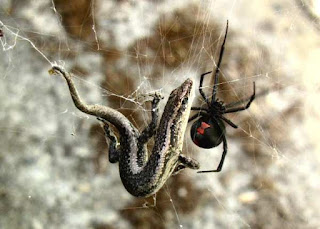Spider webs are advanced pieces of evolutionary engineering. They are also collecting vats for what lives in the neighborhood. The DNA of what a spider had for dinner remains on the web for months.
Silk from spiders webs is in demand for potential pest management, conservation, biodiversity monitoring and biogeography. It is a natural source of accumulated data and analysis of it is informative. If the DNA makeup of a web changes then something is wrong.
In the tests, black widow spiders were kept alive by feeding them with crickets. When a spider died its DNA remained on the web for 88 days. In the wild, the net of the web catches insects, small animals and flora debris.
Going out and getting some web silk is proving to be a valuable way of monitoring changes in spider populations, particularly when new species move into an area. Importantly, an eye can be kept on those on the endangered list. The method is only good for small animals because large ones
take the whole web with them.◆ Biology by Ty Buchanan ◆
●
Australian Blog ★ Adventure Australia
ALL BLOG ARTICLES· ──► (BLOG HOME PAGE)
SPIDER WEBS GIVE DNA DATA
ALL BLOG ARTICLES· ──► (BLOG HOME PAGE)
SPIDER WEBS GIVE DNA DATA
. . . . . . . . . . . . . . . . . . . . . . . . . . . . . . . . .
#black #widow #spiders #silk #insects #hunt #prey #food #dna
black widow spider catches a lizard in its web dna analysis testing method research articles news politics economics society anthropology historiography history sociology people nations country asia europe africa u.s. south america central Mediterranean eastern western interesting funny technology
#black #widow #spiders #silk #insects #hunt #prey #food #dna
black widow spider catches a lizard in its web dna analysis testing method research articles news politics economics society anthropology historiography history sociology people nations country asia europe africa u.s. south america central Mediterranean eastern western interesting funny technology




